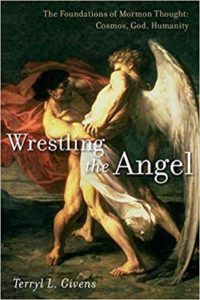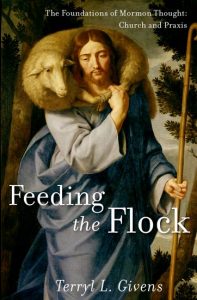 Title: Wrestling the Angel – The Foundations of Mormon Thought: Cosmos, God, Humanity
Title: Wrestling the Angel – The Foundations of Mormon Thought: Cosmos, God, Humanity
Author: Terryl L. Givens
Publisher: Oxford University Press
Genre: Mormon History and Doctrine
Year Published: 2014
Number of Pages: 424
Title: Feeding the Flock – The Foundations of Mormon Thought: Church and Praxis
Author: Terryl L. Givens
Publisher: Oxford University Press
Year Published: 2017
Number of Pages: 424
Reviewed by Peter Wilson
Terryl Givens’ Wrestling the Angel and Feeding the Flock are an investigation of “the essentials of Mormon teaching” in the historical and theological context of Western Christianity (WTA, xi). Given the church’s restorationist claims, such an investigation can bring up uncomfortable questions: if the doctrines of the church are simply a mashup of beliefs that circulated Joseph Smith’s environment, can the church’s narrative of a long apostasy and restoration really be true?
Sometimes, our beliefs are not as unique as I have thought they are.
The famous verse of “O My Father” written by Eliza R. Snow that references Heavenly Mother has rhetorical similarities in a Shaker preacher’s poem:
To whom does woman owe her birth?
Did she originate
From nothing but her mother earth,
In her primeval state?
Can any one suppose she was,
From Adam’s rib alone,
Without a corresponding cause,
From the eternal throne?
 The Church’s teachings on spiritual gifts and miracles seem somewhat consistent with Joseph Smith’s peers’ teachings. Early Protestant thinkers were skeptical of Catholic claims of miracles, relics, exorcisms, and visions. Spiritual gifts therefore were not part of many early Protestant churches. The Second Great Awakening in America was characterized by a rejection of this early Protestant tendency, and Shakers, Methodists, and Presbyterians had dramatic manifestations of spiritual gifts. Mormonism’s embrace of spiritual gifts actually seems restrained when compared to its early American context.
The Church’s teachings on spiritual gifts and miracles seem somewhat consistent with Joseph Smith’s peers’ teachings. Early Protestant thinkers were skeptical of Catholic claims of miracles, relics, exorcisms, and visions. Spiritual gifts therefore were not part of many early Protestant churches. The Second Great Awakening in America was characterized by a rejection of this early Protestant tendency, and Shakers, Methodists, and Presbyterians had dramatic manifestations of spiritual gifts. Mormonism’s embrace of spiritual gifts actually seems restrained when compared to its early American context.
Joseph’s revelation on the kingdoms of glory contradicted the then common notion that “hell was . . . a more popular venue than heaven” (WTA, 241). But Joseph was not alone in this countercultural crusade; in fact, some of his notions align with Universalist teachings, which Joseph would have been exposed to through his paternal line (his grandfather Asael was a Universalist). The Universalist Charles Beecher (of legendary Beecher family fame!) taught that “the offers of salvation are made to men after death” and that “God, to affect men, overstates the reality of future punishment” (WTA, 245). These statements align with what is taught in Doctrine and Covenants (see Doctrine and Covenants 138:28-32, and Doctrine and Covenants 19:4-12).
Where Joseph does vary from Universalists is in his emphasis on ordinances and priesthood. Vicarious ordinances for the dead were practiced in the 2nd century and then by a short-lived 300-person eccentric religious community in the 18th century in Pennsylvania before the Church of Jesus Christ of Latter-day Saints began the practice (FTF, 163). Given the strong anti-Catholic sentiments of Joseph’s environment, this was an unpopular development, but the concept of priesthood is deeply embedded in Joseph’s early revelations (see Joseph Smith History 1:38). Authors and preachers would demean Mormonism and Catholicism in the same breath.
Givens portrays Mormon doctrine on the fall of Adam and Eve as quite unique in Christianity. There was a tradition of a “fortunate fall,” but, as Givens writes, “the fall is fortunate insofar as the human sin of infinite hubris called forth the unspeakable gift of Christ’s infinite grace . . . The fall is divinely mitigated disaster, but it is first and foremost a disaster. Not so in Mormonism . . . The fall itself is fortunate, insofar as it unleashes not the triple scepter of sin, death, and depravity but the possibilities of human incarnation and the educative processes of mortality” (WTA 184-185). In Joseph’s retelling of Adam and Eve, both Adam and Eve look back on the partaking of the fruit of knowledge of good and evil and their expulsion from Eden as a positive development for humankind (Moses 5:10-11).
Givens does not use his research to comment on the church’s narrative of apostasy and restoration. That allows space for the reader to consider an overview of Christian teaching alongside teachings of the Church and reach their own conclusions, but it does mean that the books lack a central argument that might make the books more readable. Seeing Joseph Smith’s ability to draw from different aspects of his environment, go against popular opinion, and articulate doctrines that were innovative or had been dormant for hundreds of years did reinforce my belief that he was a remarkable and inspired man. As Wrestling the Angel and Feeding the Flock are dense, not plot or argument-driven books, it may be difficult to read them through. However, these books are thorough and encyclopedic in their overview of Mormon teaching and would be highly valuable on a consult-by-topic basis, and I anticipate referencing them again.
